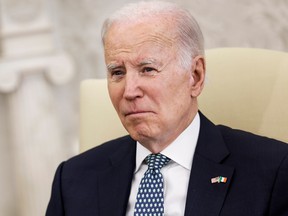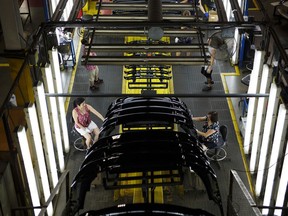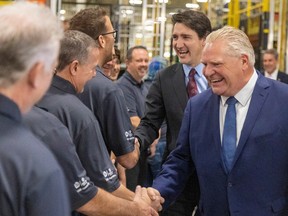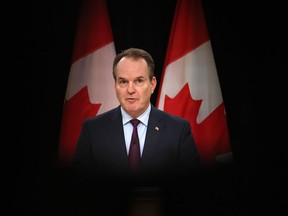Freeland being urged to create framework to guide billions promised to companies to accelerate shift to greener economy
Article content
An economic idea that fell out of fashion with stonewashed denim in the 1980s appears to be making a comeback: industrial policy, or the idea that the free market alone won’t save the economy.
Advertisement 2
Article content
Earlier this month, Deputy Prime Minister Chrystia Freeland hosted a hybrid meeting in Toronto with leaders from several environmental non-profits and think thanks, including Clean Prosperity, the Transition Accelerator, Clean Energy Canada, the Pembina Institute and the Canadian Climate Institute, to discuss how Canada can compete with the United States, as its government pours hundreds of billions of dollars into the energy transition.
Article content
At the meeting, the discussion shifted to how Canada can develop an industrial strategy, and what was scheduled as a 45-minute meeting stretched on for two hours, according to multiple sources.
The group of policy wonks urged Freeland to devise a concrete framework to guide the billions of dollars the federal government — alongside many of the provinces — has promised to give to automakers such as Volkswagen Group, battery manufacturers, steel companies and others to accelerate the shift to a greener economy.
Advertisement 3
Article content
They need to outline our competitive advantages
Mark Zacharias, chief executive, Clean Energy Canada
“The federal government, over the next 18 months, needs to start thinking about ‘What does a broader Canadian industrial strategy look like?’” said Mark Zacharias, executive director of Clean Energy Canada, whose colleague attended the meeting. “They need to outline our competitive advantages and basically start pivoting our economy towards an economy that is going to be aligned with our largest trading partners.”
What’s old is new again
Industrial strategy is often defined as a coherent and consistent set of policies that are designed to improve the performance of the economy. In the West, it’s an approach to economic policy that came to be associated with communism during the 1980s, when British Prime Minister Margaret Thatcher and U.S. President Ronald Reagan led an embrace of free-market ideologies.
Article content
Advertisement 4
Article content
By the 1990s, the idea that governments could play an active role in the economy was something that only socialists dared talk about, especially in Canada, where the Liberal government of Jean Chrétien orchestrated massive spending cuts and sold Crown assets, effectively ending the last vestiges of 1970s-era industrial policy.
Industrial policy is having a renaissance, led by economists such as Mariana Mazzucato, author of The Entrepreneurial State (2015) and Mission Economy (2021), to force a broad rethink of the government’s role in the economy. Mazzucato and others have argued somewhat successfully that tectonic shifts such as climate change and the acceleration of digital technology are too big for the free market to handle, at least in a way that will benefit society.
Advertisement 5
Article content
Although some economists may disagree with Mazzucato’s arguments, one of the reasons that Freeland is under pressure to deploy Canada’s resources to accelerate the energy transition is because U.S. President Joe Biden — who is scheduled to visit this country on March 23 — has chosen to do so.
In August, Biden signed the Inflation Reduction Act (IRA), legislation that empowers Washington to spend hundreds of billions of dollars to make the U.S. the global leader in clean technology.

Some outside experts estimate that the bill will unlock US$1.7 trillion of public and private investment into the green economy over the next decade, a figure that is almost as large as Canada’s annual gross domestic product.
Even the most committed champions of industrial policy say it would be impossible for Canada to devise policies that would attract a similar level of investment in the green economy. But that doesn’t mean they think Ottawa and the provinces should concede. Freeland is under pressure to use her budget on March 28 to allocate significant funding — perhaps tens of billions of dollars — towards renewable energy, sustainable fuels, the electric vehicle and critical mineral supply chain, and other parts of the green economy.
Advertisement 6
Article content
“I think Canada needs to be very judicious about where our competitive strengths are,” said Robert Asselin, senior vice president, policy at the Business Council of Canada.
Asselin said Canada lacks the resources that either the U.S. or China possess to pour into energy transition investments. But a well-thought out industrial policy can still drive economic growth.
‘We need a vision’
In her writing, Mazzucato stresses that industrial policy is about much more than spending lots of money. She says governments must target areas in which they can both win and make a societal impact, and develop a coherent strategy that ensures policymakers, businesses and civil society avoid working at cross-purposes.
The IRA offers sector-wide subsidies, such as production credits for hydrogen or for electric vehicles to name two examples. Although Canada has devised tax credits for companies that invest in carbon capture, which could be used by natural gas companies to produce hydrogen, much of its focus on developing an electric vehicle industry has hinged on one-time deals — negotiated subsidies to specific companies on a one-time basis.
Advertisement 7
Article content
“We’re trying to build a net-zero economy, so we need a vision of what that looks like in 2050 and we need a set of strategies to get us there,” said Bentley Allan, a professor of political science at Johns Hopkins University in Baltimore, Md., who is also research director at the Transition Accelerator, a Canadian think tank focused on the energy transition.
Allan critiqued the federal government’s approach to the green transition as too piecemeal. Prime Minister Justin Trudeau has had success enticing major automakers and battery companies to invest in Canada, but Allan said the federal government lacks a strategy to ensure that subsidies are dispersed widely, and not just among major incumbent companies such as Volkswagen and General Motors Co.
Advertisement 8
Article content

“The incumbent firms are not your best guides for either the vision or the pathway because we have to spin up new things,” said Allan. “Working with experts who understand how these systems are going to to work is really crucial.”
Allan urged Freeland to establish panels with independent experts in key sectors of the green economy, which would work across government agencies to devise policies that set specific goals: For example, in biofuels, a tax or operating credit that would be expected to lead to a specific production targets.
Allan and Michael Bernstein, executive director of Clean Prosperity, released a report on Feb. 23 that offered specific sectors where they think Canada could invest so that it can continue to grow its trade relationship with the U.S. as the IRA transforms that country’s economy: the country’s mining and exploration sector could help feed a battery manufacturing sector, which would tie into the existing auto sector; Alberta’s natural gas resources could be combined with carbon capture to create a hydrogen sector — to name two examples they cite.
Advertisement 9
Article content
Bipartisan embrace
The meeting with Freeland was ostensibly to discuss the paper, and other climate groups were included so that a diversity of opinions and political leanings were present.
“The global economy is undergoing the most significant transformation since the Industrial Revolution, and Canada cannot be left behind,” Adrienne Vaupshas, press secretary for Freeland said in a statement. “This is a once-in-a-generation opportunity, and we will continue working hard to create more middle-class jobs, invest in our communities, and build a more prosperous Canada for generations to come.”
It’s perhaps unsurprising that Freeland would be open to rethinking industrial policy. She embraced with open arms the concept of “friendshoring,” a protectionist trade strategy that would see Democratic allies use regulation, sanctions and the public purse to weaken the hold of authoritarian powers such as China and Russia on key supply chains. And the Trudeau government has developed a reputation for profligacy.
Advertisement 10
Article content
But industrial policy isn’t something leftish governments are pushing on their own. A political consensus has coalesced around a green energy strategy, where investing in the energy transition is no longer seen as merely central to saving the planet, but also viewed as key to saving the economy by politicians across the spectrum.

In Ontario, for example, the federal Liberals have worked closely with Premier Doug Ford’s Progressive Conservative Party to court automakers and battery manufacturers to invest in plants, and to decarbonize heavy industry such as steel manufacturing.
Since 2020, the province’s auto sector has attracted an estimated $17 billion in investments from the auto sector, which has been aided by an undisclosed amount of federal and provincial support.
Advertisement 11
Article content
Vic Fedeli, Ontario’s minister of economic development, job creation and trade, said that he and François-Philippe Champagne, the federal industry minister, text often and worked hard to court Germany’s Volkswagen, which has announced it will build a battery manufacturing plant in St. Thomas.
“The way to win is to work together,” said Fedeli, adding, “We may have different reasons that we want to bring this business here.”
The way to win is to work together
Vic Fedeli, Ontario minister of economic development
Fedeli emphasized that his government has not raised taxes, and has made cuts in areas such as workers’ compensation that lower the cost of business for companies operating in Ontario.
But he also acknowledged that Ontario’s electrical grid, and its low-emission profile have proven to be an important draw for automakers. Indeed, he said the province invested alongside the federal government in electric arc furnaces to lower the carbon footprint of provincial steel plants, which was also important to automakers building electric vehicles.
Advertisement 12
Article content
Fedeli even commended labour unions at auto companies for being strong partners.
The teamwork around attracting automakers is seen by some as an important reflection of a political shift taking place.

Bruce Lourie, president of the Ivey Foundation, a charitable foundation focused on the net-zero transition in Canada, said that until recently, climate change was seen exclusively as an environmental issue, which created political polarization, and environmentalists were seen as fighting industry.
“Climate has become almost secondary now in terms of the focus of the conversation,” Lourie said. “We’re going to have electric vehicles. The Canadian government doesn’t decide that. The world has already made that decision. The question for Canada is do we want to manufacture them? The cathodes? The minerals that go into the cathodes?”
Advertisement 13
Article content
Without an industrial policy lens, Canada won’t be able to maximize its economic growth, Lourie said.
Dan Wicklum, chief executive of the Transition Accelerator, said that a consensus around the need for an industrial strategy has been growing over the past 18 months, as Europe, the U.S., and many other countries enacted policies that set up specific sectors to succeed in a net-zero economy.
There’s no question the pendulum is swinging
Dan Wicklum, chief executive, Transition Accelerator
As Canada’s major trading partners have “gone all-in” on reaching net-zero, Wicklum also made the case that the impetus to fight climate change shifted from reducing emissions to save the planet to reducing emissions to keep the economy competitive.
Wicklum and Allan have been holding meetings with various government ministries, briefing them on the mechanics and theory for why an industrial policy is necessary.
Advertisement 14
Article content
The Net Zero Advisory Body, a group formed in 2021 to advise the federal government on interim emission reductions targets and pathways to net-zero, which Wicklum chairs, even called for an industrial strategy in its latest report this past January.
“There’s no question the pendulum is swinging,” said Wicklum. “Governments are taking much more prescriptive strategies to make sure they have the supply chains, value chains, sectors and companies .. to not just get to net zero, but also to win in that new world.”
Still, an industrial policy remains politically fraught because the government will have to allocate finite resources: whether to use scarce resources to de-risk carbon capture technology for oil and gas companies at a time when many are reaping record profits; or to instead allocate money to de-risking emerging technologies will undoubtedly spur debates.
-

New optimism critical minerals gap with China can be closed
-

Mining guru says U.S. Inflation Reduction Act ‘changed everything’
-

What lies ahead for Canada as it seeks to reduce carbon emissions
Asselin said that historically the government has taken a piecemeal approach, and picked companies as winners. Instead it needs to take a holistic approach that picks sectors.
“Picking sectors is not the same as picking firms,” he said, adding that he hopes that any industrial strategy focuses on the former.
• Email: gfriedman@postmedia.com | Twitter: GabeFriedz
Industrial policy back in vogue in push for Canadian green economy win
2023-03-21 13:52:30







Comments
Postmedia is committed to maintaining a lively but civil forum for discussion and encourage all readers to share their views on our articles. Comments may take up to an hour for moderation before appearing on the site. We ask you to keep your comments relevant and respectful. We have enabled email notifications—you will now receive an email if you receive a reply to your comment, there is an update to a comment thread you follow or if a user you follow comments. Visit our Community Guidelines for more information and details on how to adjust your email settings.
Join the Conversation